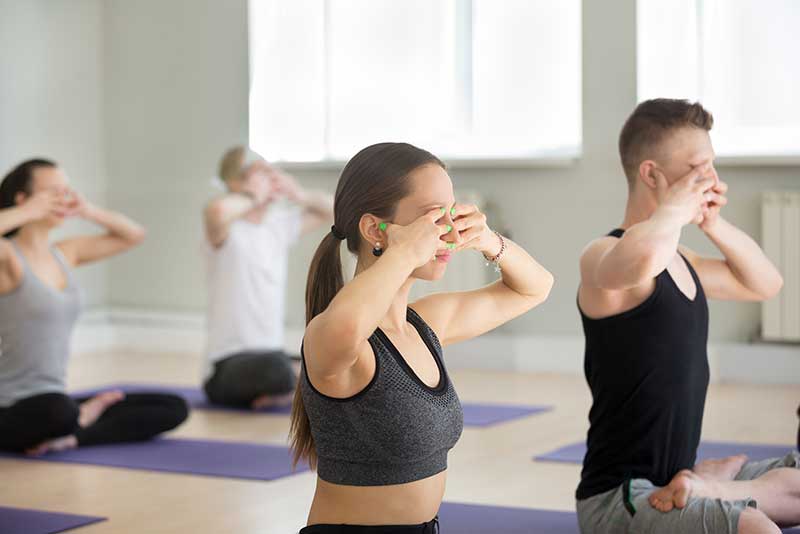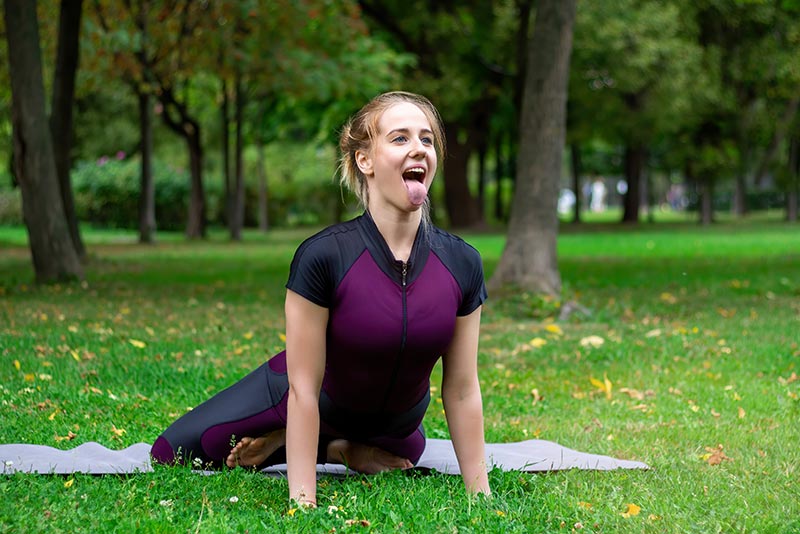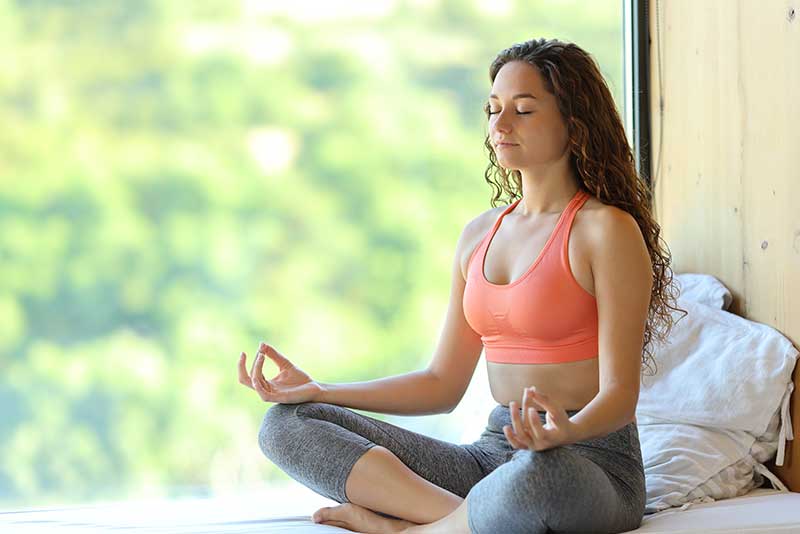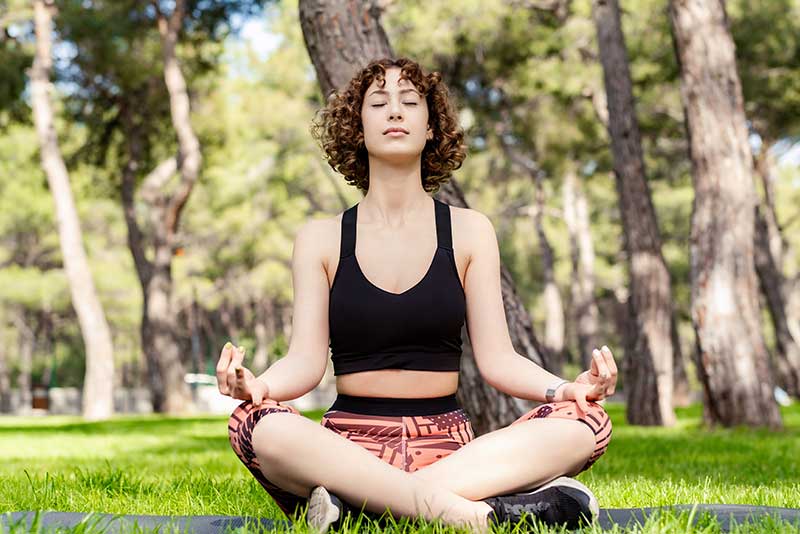You may have noticed that when you are stressed your breath becomes shallow and shorter. When we are stressed, our body activates the fight or flight response. It is the response of the body to confront any danger. We cannot avoid stress all the time, but we can develop a healthier way of responding to it. Focusing on the breath is one of the best relaxation techniques that makes you calm and relaxed. Take a deep breath and you will notice a great difference in how you are feeling. When you are stressed, your breath is a powerful tool to ease your stress and make you relax. Here, we’ll walk you through some effective deep breathing exercises for stress relief.
Breathing exercises for stress management
Here are some simple deep breathing exercises for stress management.
1. Diaphragmatic Breathing

Diaphragmatic breathing, also known as belly breathing, focuses on engaging the diaphragm for deeper breaths. This technique helps in fully utilizing the lung capacity, promoting relaxation and reducing stress.
How to Do It
- Sit on a chair or lie on a bed.
- Place your left hand on your upper chest and the right on your stomach.
- Inhale deeply through your nose, allowing your belly to rise.
- Hold your breath for a moment.
- Exhale slowly through your mouth, aiming to make the exhalation twice as long as the inhalation.
Benefits
- Reduces stress and anxiety.
- Lowers heart rate and stabilizes blood pressure.
- Improves core muscle stability.
- Enhances relaxation and sleep quality.
Precautions
Ensure you are in a comfortable position to avoid any strain on your back or neck. If you feel dizzy or lightheaded, stop and return to normal breathing.
2. Alternate Nostril breathing

Alternate nostril breathing, or Nadi Shodhana, is a pranayama technique in yoga that balances the body’s energies and calms the mind. It involves alternating breaths between the nostrils to promote mental clarity and tranquility.
How to Do It
- Sit in a cross-legged position with your back straight and palms resting on your thighs.
- Close your right nostril with your right thumb and inhale deeply through your left nostril.
- Close your left nostril with your ring finger and exhale through your right nostril.
- Inhale through your right nostril, pause, then close your right nostril and exhale through your left nostril.
Benefits
- Balances the left and right hemispheres of the brain.
- Enhances respiratory function.
- Reduces stress and anxiety levels.
- Improves concentration and mental clarity.
Precautions
Practice in a quiet, comfortable environment. Avoid if you have nasal congestion or breathing difficulties.
3. Bhramari Pranayama

Bhramari Pranayama, also known as the humming bee breath, is a calming breathing technique that uses sound and breath to soothe the nervous system and reduce stress.
How to Do It
- Sit in a cross-legged position with your back straight.
- Close your eyes and gently close your ears with your thumbs.
- Place your forefingers on your eyebrows and cover your eyes with the rest of your fingers.
- Inhale deeply through your nose.
- Exhale slowly while making a humming “om” sound with your mouth closed.
Benefits
- Calms the mind and reduces stress.
- Helps in anger management.
- Improves concentration and memory.
- Reduces blood pressure and alleviates insomnia.
Precautions
Ensure you are seated comfortably to avoid straining your back. If you feel any discomfort or dizziness, stop and resume normal breathing.
4. Lion’s Breath

Lion’s Breath, or Simhasana, is a dynamic breathing exercise that relieves tension and stress by engaging the facial muscles and diaphragm.
How to Do It
- Sit on your heels with your hands on your knees and fingers spread like claws.
- Inhale deeply through your nose.
- As you exhale, open your mouth wide, stick your tongue out, and make a loud “Haa” sound.
- Try to bring your gaze towards the center of your eyebrows or the tip of your nose as you exhale.
- Repeat for 3 to 4 breaths.
Benefits
- Relieves tension in the face and chest.
- Reduces stress and anxiety.
- Improves circulation in the face and throat.
- Enhances vocal strength and clarity.
Precautions
Avoid straining your neck and throat. Practice in a comfortable, quiet space, and stop if you experience any discomfort.
5. Pursed Lip Breathing

Pursed lip breathing is a simple technique that helps make breaths more effective by slowing down the breathing process. This method is particularly beneficial for people with lung conditions such as COPD.
How to Do It
- Sit in a comfortable position, relaxing your neck and shoulders.
- Inhale slowly through your nose for a count of two.
- Purse your lips as if you were going to whistle.
- Exhale slowly through your pursed lips for a count of four.
Benefits
- Improves ventilation and oxygen exchange.
- Reduces shortness of breath.
- Helps in controlling breathlessness during physical activities.
- Promotes relaxation and reduces anxiety.
Precautions
Ensure you are breathing slowly and not forcefully. If you feel dizzy or uncomfortable, stop and return to normal breathing.
6. Equal breathing

Equal breathing, or Sama Vritti, is a balanced breathing technique that involves inhaling and exhaling for the same duration. This method helps in calming the mind and improving focus.
How to Do It
- Sit or lie down in a comfortable position.
- Close your eyes and inhale slowly through your nose for a count of four.
- Exhale slowly through your nose for a count of four.
- Continue this cycle, maintaining equal duration for inhalation and exhalation.
Benefits
- Balances the autonomic nervous system.
- Promotes mental clarity and focus.
- Reduces stress and induces relaxation.
- Improves overall lung capacity and efficiency.
Precautions
Practice in a quiet environment free from distractions. Avoid if you have any respiratory issues that make it difficult to breathe through your nose.
7. Skull-Shinning breath

Skull-shining breath, or Kapal Bhati, is a powerful breathing technique in yoga that involves forceful exhalations to energize the mind and cleanse the respiratory system.
How to Do It
- Sit straight in sukhasana (easy pose) with your hands resting on your knees.
- Take a deep inhale through your nose.
- Exhale forcefully through your nose by contracting your abdominal muscles.
- Allow the inhalation to happen naturally without effort, focusing on the forceful exhalation.
- Practice this for at least 12 to 15 breaths and then relax.
Benefits
- Increases oxygenation and energizes the brain.
- Cleanses the respiratory system.
- Enhances digestive functions.
- Improves concentration and mental clarity.
Precautions
Do not practice this technique if you have high blood pressure, heart problems, or any respiratory conditions. Always perform it on an empty stomach.
8. Resonant and coherent breathing
Resonant and coherent breathing involves taking slow, steady breaths to achieve a specific breathing rate, typically around five breaths per minute. This technique helps synchronize heart rate variability, promoting relaxation and reducing stress.
How to Do It
- Sit or lie down comfortably.
- Inhale slowly through your nose to the count of five.
- Exhale slowly through your nose to the count of five.
- Repeat this process for a few minutes, maintaining the slow and steady pace.
Benefits
- Reduces stress and anxiety.
- Promotes heart health by improving heart rate variability.
- Enhances overall well-being and relaxation.
- Improves concentration and mental clarity.
Precautions
Ensure you are in a comfortable position and avoid straining. If you feel lightheaded or uncomfortable, stop and breathe normally.
9. Deep Breathing

Deep breathing is a simple yet powerful technique that involves taking slow, deep breaths to maximize oxygen intake. This method helps to calm the mind and body, making it a great tool for stress relief.
How to Do It
- Sit comfortably, keeping your shoulders and neck relaxed.
- Inhale deeply through your nose, ensuring your lungs are completely filled with air.
- Hold your breath for a moment.
- Exhale slowly through your nose, ensuring your lungs are completely emptied.
- Repeat this process for several breaths.
Benefits
- Reduces stress and anxiety.
- Lowers heart rate and blood pressure.
- Enhances lung capacity and function.
- Promotes overall relaxation and well-being.
Precautions
Practice in a quiet environment to avoid distractions. If you experience any discomfort or dizziness, stop and breathe normally.
10. Mindful breathing

Mindful breathing is a meditation technique that focuses on being aware of your breath and the sensations in your body as you breathe. This practice helps to anchor your mind in the present moment, reducing stress and promoting relaxation.
How to Do It
- Sit or lie down in a comfortable, quiet place.
- Close your eyes and focus on your breath.
- Notice the sensations in your body as you inhale and exhale.
- Allow your thoughts to pass without judgment, returning your focus to your breath.
- Continue this practice for several minutes.
Benefits
- Reduces stress and anxiety.
- Enhances mindfulness and presence.
- Improves concentration and focus.
- Promotes emotional regulation and resilience.
Precautions
Ensure you are in a quiet, comfortable environment to avoid distractions. If your mind wanders, gently bring your focus back to your breath without judgment.
Bottomline
Your breath is a powerful tool against day-to-day stress. You will learn to manage stress with the help of these deep breathing exercises technique. If you feel that you are struggling then practice one or two at a time. With gradual practice, you will start feeling better and notice that you have become more calm and resilient towards stress.
FAQs
References:
https://www.ncbi.nlm.nih.gov/books/NBK545289/
https://www.ncbi.nlm.nih.gov/pmc/articles/PMC7602530/
https://www.ncbi.nlm.nih.gov/pmc/articles/PMC5755957/
https://www.ncbi.nlm.nih.gov/pmc/articles/PMC3968697/

Anjani Kumar Shrivastava, a distinguished yoga expert with decades of experience, brings healing and wisdom through yoga therapy, meditation, and Ayurvedic principles. His remarkable Read more



